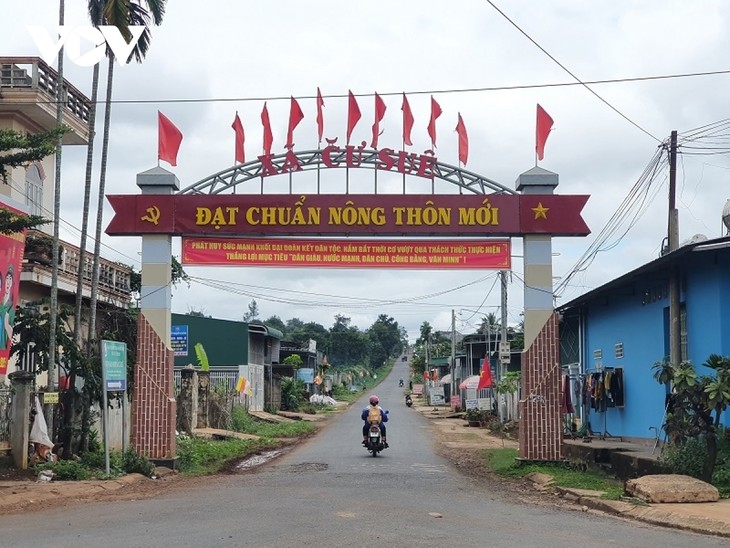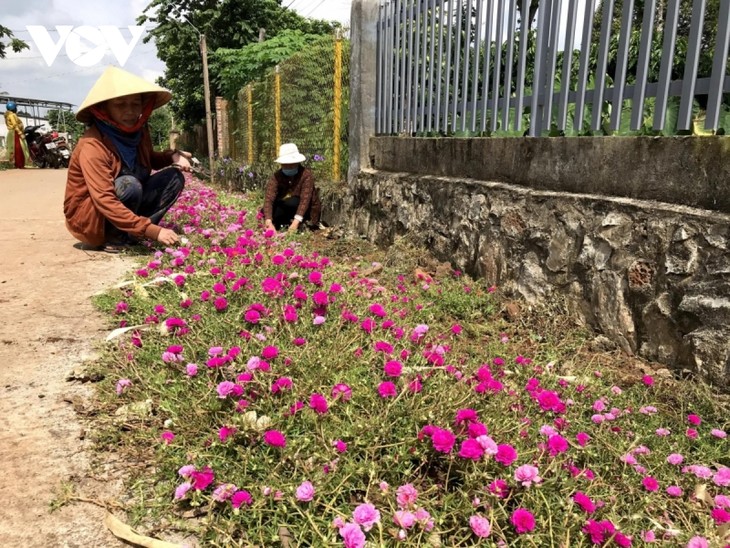(VOVWORLD) - Many hamlets in the Central Highlands region have prospered thanks to the national target program on new-style rural building. Cu Sue commune in Dak Lak province is one example. As soon as the commune was added to the power grid and the local road, school, and medical clinic were upgraded, local productivity began to improve.
 The road leading to Cu Sue, a new-style rural hamlet in Cu Mgar district, Dak Lak province The road leading to Cu Sue, a new-style rural hamlet in Cu Mgar district, Dak Lak province (Photo: Nguyen Hieu)
|
Cu Sue is an agricultural commune with 80% of the population doing farming. To make the new-style rural building program effective, the local administration has directed villagers to accelerate crop and livestock restructuring and apply technology to production to increase their income and stabilize their life. Rising incomes makes them more willing to contribute to building a new-style rural area.
In the first stage of the program, Cu Sue commune raised approximately 1.9 million USD, a third of which was contributed by the villagers in addition to 1,500 man-days of volunteer labor. The people also voluntarily donated land for rural infrastructure improvement.
Sut Hluot hamlet now sees newly paved roads, a cleaner environment, more spacious houses, and happier faces. H Dan Nie, the hamlet chief, said proudly that Sut Hluot, which used to be a poor, backward area, has changed completely. The improved roads make it easier for local farmers to sell their produce. Living conditions have improved and people’s level of awareness has been raised.
H Dan told VOV, “The most obvious change is people's awareness. In the past, for example, villagers used to organize long funerals and other mass gatherings according to traditional customs and practices. Since new-style rural building was implemented, the duration of gatherings has been shortened to protect public health. Transportation has improved. Houses are more spacious. The number of poor households has declined. Children of school age can go to school.”
The other 10 hamlets in Cu Sue have seen similar changes since the national program on new-style rural building began. Roads have been paved and nearly everyone now has access to electricity. This has boosted production, enabling greater investment in culture, health, and education. More than 88% of households have safe water and almost every household has access to electricity.
According to Y Hoa Nie, a resident of Sut Mdung hamlet, “People's living conditions have improved because rural roads have been paved. To boost incomes, technology has been applied to growing coffee, helping the locals increase the productivity of small growing areas. People’s knowledge of modern farming techniques has improved.”
 Women in Cu Sue hamlet decorate the village roads with flowers. (Photo: Do Lan) Women in Cu Sue hamlet decorate the village roads with flowers. (Photo: Do Lan) |
Dang Van Hoan, Chairman of Cu Sue commune’s People's Committee, said that of 11,300 people living in 2,000 households in 11 hamlets in Cu Sue, 60% are ethnic minority people. In the past, 35% of the households were poor. Now that figure is just 3%, thanks to the new rural program. Last year the commune's per capita income reached 2,300 USD.
Hoan says Cu Sue’s administration will continue to raise the standards for new rural building, with special attention to economic development.
“The local administration has called on people to restructure crops and build collectives to buy all raw materials from local farmers. A coffee cooperative will be set up in the locality to improve the value chain and the quality of products. More attention will be given to community-based tourism for poverty reduction and economic development,” said Hoan.